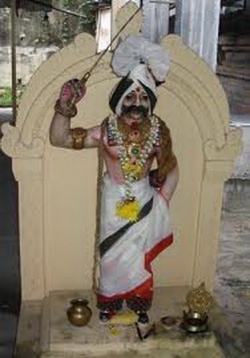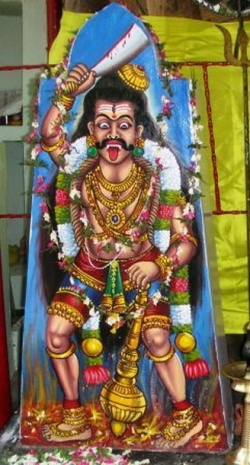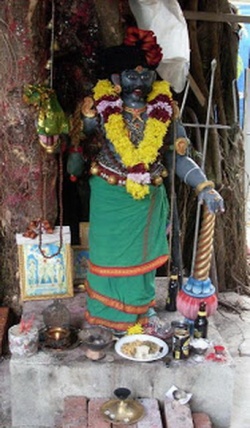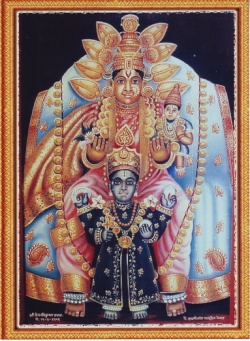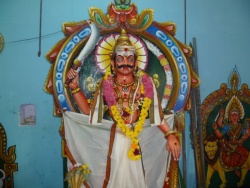The system of Mantrayana kuladevata-s, the Family of Deities.
Article Submitted By: GeorgeFarrow
Date: Mon, 14 May 2012 Time: 10:48 AM
A brief view regarding the system of the Buddhist Vajrayana/Mantrayana, kuladevata-s, Family of Deities.
' The deity originates in the body and so is called devata, deity.
Hevajra-tantra (H.T.,) 1.5.12. The H.T., is the root treatise of the 'blue' Wrath Family.
The overall Buddhist tantric, Vajrayana/Mantrayana method, based upon prajna, Wisdom and upaya, Means, is exposed and surveyed within the various annutara-yoga tantra-s, the Unsurpassable Yoga Treatises.
Within these root tantra-s the advanced method of emanation, yoga and cosmic yoga rests upon the applied system of krama-s, Processes.
Initially there were 'two' basic processes applied within the Vajrayana/Mantrayana, Wisdom and Means method.
These were the upattikrama, the Process of Generation and the utpannakrama, the Process of Completion.
Originally during the early pre-6th., century AD., period, the 'two processes' were generally practiced in connection with the mahayoga-tantra, the Great Yoga System of the Unsurpassable Yoga System.
But after the 6th., century AD., period, a further process, the nispannakrama, the Process of Perfection arose and was also applied in connection with the yogini-tantra, Female Yoga System of the overall Unurpassable Yoga System.
In addition to the 'two processes', the Process of Perfection is the third and culminating cosmic process applied within the Unsurpassable Yoga System.
The Process of Generation is comprised of the techniques of visualization and emanation.
The Process of Completion is comprised of the techniques of vaya-yoga, the 'yoga of the winds' and the Process of Perfection is comprised of the techniques of 'cosmic yoga' where the 'five offerings to the senses', including the 'erotic offering' are enjoyed.
The Vajrayana/Mantrayana system of ‘processes’ is aimed towards the goals of the graduated techniques of emanation; the stages of the v›yu-yoga, the ‘yoga of the winds’ as well as the ultimate goal cosmic yoga.
The techniques of the processes are applied to re-focus/transform the habitual emotional tendencies of the dualistic mind and the allied breath patterns towards an appreciation of the inherent non-arisen nature of the re-focused mind stream ‘sealed’ within the central nerve.
Through the initial mode of visualization/identification with the non-substantial form of the appropriate elemental/emotional 'wisdom' deity,
the re-focused undifferentiated mind can eventually be further fully transformed from application to the ‘yoga of the winds’.
The techniques of the ‘yoga of the winds’ are aimed at channeling the electromagnetic and bio-kinetic energies of the body with a view to awakening the inner ‘secret fire’ of the life force.
By ‘awakening’ to the overdrive of the life force, the nerves, spinal sources of sensory mind can be ‘sealed’ within the sphere of the purified central nerve.
As mentioned, historically only during the advanced stages of the Female Yoga Practitioner system was a radical ‘sanctified’ erotic approach applied.
This very advanced yoga technique applied by accomplished adepts can lead to comprehensive counter-action and the total transformation of all dualistic emotional tendencies.
Clearly because of the possible use of erotic techniques in the advanced application of the yoga of the winds the tantric system has to be approached and appreciated in a very disciplined and wary manner.
Certainly, even for very accomplished practitioners if this erotic technique is incorrectly applied by resorting to gross eroticism this can lead to a fall.
Then even advanced practitioners can be overwhelmed, blinded by gross passion and can thereby become re-involved within greater degrees of ignorance, delusion and consequent suffering.
However if the mind stream is deliberately, efficiently so ‘sealed’ within the sphere of the 'middle' nerve that unifies the spinal centers, this ‘sealed’ consciousness can rest within the inherently released ‘natural’ state.
Here once consciousness is purified, ‘released’, it is freed from the any obstructions generated by sensory cause and effect;
the limiting progressions of transitory matter, the relative tendencies of emotional mind and of thought constructs etc.
Efficiency in this mode of advance cosmic yoga in company with offering the tantric sacraments to the senses allows all relative mental obstructions and the dualistic veils of ignorance, generated by the conditioning of sense-based, karma, cause and effect, to be eventually resolved.
As a consequence the mind stream of the efficient practitioner can be established within the indivisible sahaja, the ‘innate’ or ‘natural’ state of Wisdom, even while sensory interplay continues in this life.
The successful application of the Processes can lead the Buddhist tantric adept towards the realization of the non-dual samvara, the 'concealed essence';
the svabhava, the 'essential nature' and/or the non-dual sahaja, the 'innate, natural consciousness'.
The methodology of the 'three processes' could only be received from a Vajrayana/Mantrayana lineage master and are firmly linked to the catur-abhisheka, the 'four divisions' of Buddhist tantric 'consecration'.
These are 'four consecrations' are the acarya-abhisheka, the Master Consecration, the guhya-abhisheka, the Secret Consecration, the prajna-abhisheka, the [[Wisdom Consecation[[ and the caturtham, the Fourth.
These 'four consecrations' can be experienced by Buddhist tantric yogi-s when applying the carya,
the 'application of the vow' relating to the catur-ksana, 'four moments' and the catur-ananda, 'four joys'.
The various root tantric treatises of the Female System, including the HT., the canda-maharosana-tantra (CMR.T.,) survey and discuss the upaya, the 'means' of the 'four' stages of tantric consecration.
The various ‘means’ are geared to the 'four' stages of the carya, the 'application of the vow' suited to the bhava, the inner 'sensibility' of the 'four' degrees of consecrated 'worthy' disciples.
The various types of 'worthy' tantric disciples are said to possess mild, medium, strong and very strong degrees sensibility to realizing the innate non-dual 'essential nature'.
According to the YRM., commentary the means of the 'master consecration' are applied to lead the 'worthy' disciple 'far away from unmeritorious natures' and acts as an introduction 'to the nature of the four Moments and the four Joys'.
This consecration is suited to the disciple of the mild degree of sensibility.
The means of the 'secret consecration' are applied so that the 'gem [the inner vajra] is placed in the Secret Place [spinal center, the inner lotus]...revealing the four Joys which are the nature of the four Moments in the Secret Consecration'.
The realization of this consecration is intuitive and 'is called 'secret' because it cannot be explained to the yogi in terms of phenomenal concepts'.
This consecration is suited to the disciple of the medium degree of sensibility.
The 'wisdom consecration' is 'for bestowing ...the Knowledge of Wisdom'.
Here 'wisdom' [[[absolute]] voidness] is the excellent knowledge that all [[[dualistic]]] things are merely the creations of one's own mind'.
This knowledge is attained by 'marking the 'moments' by means of the gem placed at the confluence of the [main] three nadi-s, 'yoga nerves'.
This consecration is suited to the disciple of the strong degree of sensibility.
After the 'wisdom consecration' then the YRM., states: '...after that the Fourth thus'. Here 'that ' refers to the Consecration of the Knowledge of Wisdom.
Here 'thus' [evam] is synonymous with Thusness, the Absolute Void and the Essence of Nature'.
This consecration is suited to the disciple of the very strongest degree of sensibility.
During the pre-10th., century period the third and fourth consecrations were experienced by the tantric yogi 'with an external consort...[based] upon a technique of yoga which does not depend on anything [analambanayoga] and is pervaded by the Signless Moment where it is not possible to determine any definite place of origination'.
As mentioned the three processes of the Female Yoga System also include the radical, ‘sanctified’ cosmic yoga techniques that form part of the 'five' tantric sacraments to the senses.
Within the Buddhist tantric method, the 'five' tantric sacraments to the senses are similar to 5M's of Hindu tantra and formed the cosmic yoga method applied by accomplished, adept yogi-s .
In the same way to the techniques of the Hindu kula-yoga, these sacraments are offered and enjoyed by the advanced, adept practitioner while the yogı's consciousness is 'sealed' within the sphere of the already purified central or 'middle' nerve.
This radical system is characterized as potentially dangerous when applied by not fully disciplined yogı-s.
But still for disciplined yogı-s, who possess the strongest sensibility, application to this radical cosmic system can be the rapid systemic approach to attaining the complete 'release' from karma, dualistic 'cause and effect' and 'release' from the residue habits of sensory duality.
The application of the Buddhist Vajrayana/Mantrayana system of emanation, yoga and cosmic yoga is essentially founded on the kuladevata or the Families of Deities.
The general concept of the 'families of deities' lies at the heart of and is essential, both within the classic emanation and yoga systems of the earlier,
ancient tantric Shaiva/Shakti tradition and the later Buddhist Vajrayana/Mantrayana tradition of the classic tantric era.
Within a general polytheistic situation, the logic of the exoteric/esoteric/cosmic Shaiva/ Shakti, this system applies the conception of the Families of Deities in an orthodox theistic manner.
This entails consecrated Hindu yogı-s to be reliant on external worship, propitiation and internal emanation etc., offered to 'chosen' theistic male or female deities.
But within the tantric Buddhist Wisdom and Means method the approach to the 'families of deities' is quite different.
This system is derived and is geared by the basic Buddhist doctrinal stance that places no emphasis on primal causal deities;
has the doctrinal stances of no-soul, no-self and therefore no doctrine on the nature of soul or the supreme soul/self unlike other Brahminical philosophical stances and Shaiva/Shakti esoteric tantric systems.
H.T., 1.5.10 defines the term kula, family and the propitiation of the deities from the view-point of the Process of Generation as:
'The kula, 'family' [of deities] is so called because of kulyate, reckoning, that is grouping the families of the five elements and the five components of phenomenal awareness'.
Further from the view point of the Process of Perfection H.T.,1.5.11 clarifies the nature of the practitioner, the [emanated] mantra and deity as:
'There is neither emanator nor the emanated, neither mantra nor deity.
Mantra and deity exist as the undifferentiated nature [of mind]'.
The YRM., comments: '...Then how is it they are perceived in the [sensory] world as aspects of the undifferentiated nature?
' [Within the sensory mind] the differentiated is characterized by plurality. '
' When devoid of the differentiated nature of the one and many they exist [in reality] as aspects of Thusness [or 'natural' non-dual consciousness] which is characterized as the non-arising nature of the differentiated'.
Under doctrinal logic governing the Process of Generation the different colored, emotional deities are viewed as originating from within the finite body/mind.
Therefore being internal the propitiation, emanation etc., of the deities are performed by the mind within the field of the body of the Buddhist tantric practitioner.
In the H.T., regarding the nature of the devata, deity, 1.5.14 states that:
'...The [[[emotional]] colored] deity originates in the body [[[dehe sambhavati]] and so is called devata, deity'.
The commentary, the YRM states that:
'Since the deity arises in the body the deity practice must be performed in the body...'. '
' [However with application to the propitiation, emanation techniques of the Process of Generation by way of purifying the internal 'in character' emotional deities, the practitioner can realize] the [[[infinite]]] non-dual knowledge [that always]...resides in the body...[and] that the non-dual knowledge is [the same nature as the consciousness of] the Buddha...'.
Under Buddhist tantric doctrinal logic the YRM., introduces H.T., 2.2.28 by stating that the accomplishment of the mahamudra, the Great Seal,
'is attained only by means of the practice of emanation [of Families of Deities]'. Here the H.T., states that after consecration:
'The holder of the vow must conceive of the differentiated world [using the family of deity system] by means of the Process Generation [in order to eventually realize the 'natural state' of mind by] making the differentiated [[[mind]] flow] dream-like [and] utilizing the differentiated, transform it into the undifferentiated '.
As previously mentioned entry in to a Buddhist tantric deity cycle can only be from the consecration of a tantric lineage master. This tantric master can accept or reject any candidate.
On acceptance the master will assess the mind set of the future disciple.
After the mind set of the 'worthy' Buddhist disciple is assessed by the lineage master he/she can be consecrated into a particular Buddhist tantric deity cycle and system.
Here the difference of objective between the Hindu tantric systems is made clear.
In Buddhist tantra the consecrated disciple internally emanates etc., the 'in character' male and female istadevata-s, 'chosen deities'.
These 'chosen deities' are applied by the disciple to purify their elementally-derived, emotional differentiated mind set.
These 'families of deities', linked to the five elemental Buddha-s of Concentration etc, have no real causal cosmic attributes but act within a system aimed at the transformation of the elemental, emotional attributes of the dualistic relative mind etc.
The eventual goal of the Buddhist tantric system is to enter into the 'natural' but normally well hidden, concealed undifferentiated mind.
Certainly under tantric logic the dualistic, relative mind set is considered 'unnatural' and illusionary when conceived alone from non-dual mind, the sahaja, the innate or non-dual 'natural state'.
The continuing relative mind set is caused by past habit and from the appearances of impure emotions that lead the individual to believe in the total existence of the duality of mind and the relative world etc.
Within the Process of Generation the 'in character' nature of these 'family of deities' therefore corresponds to the basic emotional color of the mind set of disciples.
From the lineage master's assessment of the disciple's mind set, the color of the in character 'family of deity' will be in accord with their predominate emotional characteristic.
The 'families of deities' emanating from the primeval elements actually ruled by the five Buddha-s of Concentration, are red for passion, blue for wrath, yellow for delusion etc.
Then once assessed by the lineage master a suitable disciple can be entered by the lineage master into the particular deity cycle and system of the 'chosen deity' according to their predominate emotional coloration.
Further, the icons of the non-dual male and female deities that form a deity family in fact can indicate, by means of symbolism etc., the undifferentiated mind of an adept who has become fully realized by successfully applying the 'wisdom deity' system.
Thereby the 'family of deity' system is aimed towards realizing the natural state of vajra, adamantine/indivisible, passion, adamantine/indivisible wrath, adamantine/indivisible delusion etc.
In this way the Vajrayana/Mantryana system of the Processes is founded on the utilization of the various deity families to purify the elementally-derived, dualistic emotions;
to purify the pancaskanda, the Aggregate of the Five Components of Phenomenal Awareness as well as the senses etc., all activated within the dualistic sensory mind etc.
Here these components of the dualistic sensory mind are active with the principle spinal centers of the body.
The principle spinal centers are located in the heart and the generative regions and are known by Buddhist tantric practitioners as the Father deity's solar mandala and the Mother goddess's lunar circle.
The mandala and circle are centrally situated on spine at these regions within the body of a tantric practitioner.
In the context of the Process of Generation etc., the visualization and emanation of the 'families of deities' within the Father's mandala and the Mother's circle can act as the purifying agents within the context these spinal storehouses that contain the impure emotional foundation factors; the relative sense components; sense actions and traits etc.
Therefore in the main the propitiation, visualization and emanation practices etc., of the Process of Generation are mentally performed by the tantric practitioner in the Solar mandala and Lunar circle.
The CMR.T., indicates in a metaphorical manner that these 'families' are adamantine/indivisible aspects of the innate nature.
Here from the view of the method of the Goddess the Adamantine Essence in the circle CMR.T.,1.2 states:
' He [the Bhagavan, lit., the 'one is possession of womb, the Black Immovable Adamantine Yogi of wrath] dwelt [in the wombs of the vajradhatvisvari, the Lady of the Adamantine Essence] in the company of numerous adamantine yogi-s and yogini-s.
'It is as follows: ' Amongst them were the shveta-acalena, the White Immovable Adamantine Yogi, the Yellow Immovable Adamantine Yogi, the Red Immovable Adamanitine Yogi, the Green Immovable Adamantine Yogi.
' Also among them was the mohavajraya vajrayogini, the Adamantine Yogini of Indivisible Delusion, the Adamantine Yogini of Indivisible Malignity, the Adamantine Yogini of Indivisible Passion, the Adamantine Yogini of Indivisible Envy [and the Adamantine Yogini of Indivisible Wrath as the ranking Goddess is not differentiated].
' With these Yogis and Yoginis in the forefront He was also surrounded by countless other yogis and yogini-s'.
The PA., commentary on the CMR.T., indicates the doctrinal logic of the Process of Generation.
Here the PV comments on 'with these...in the forefront':
'The intent is that the retinue consisted of the faculties of vision, smell, taste, touch and hearing; [consisted of] the Aggregate of the Five Components of Phenomenal Awareness form,
sensation, conceptualization, imprint of past actions and awareness of phenomena and the five elements earth, water, fire, air and space.
'[Thereby] the Bhagav›n remained, that is, pleasurable dwelt in the assembly together with this [[[adamantine]]] retinue [all being pervaded] with such an [indivisible] enlightened consciousness.'
Thereby the various 'in character' deity families of Buddhist tantra are applied to tame and to purify the dominant element/emotion of the 'worthy' disciple.
Under Buddhist tantric logic the dominant element/emotion of all individuals are created at the time of the conception of an embryo during the enjoyment of the sexual union of the parents.
This primordial, dominant element/emotion is that which in turn primordially drives the dualistic sensory emotional mind of the conceived child.
Therefore under Buddhist tantric logic it is the resonance of the primordial element/emotion that goes on to basically color a particular individual's sensory mind set.
But the dominate emotion is always is dominated, controlled and commenced by the dominant primordial element.
Within the wider cycle of dependent causation spanning the Aggregate of the Five Components of Phenomenal Awareness etc ., etc., it is this impure elemental/emotional coloration/resonance that forms
dualistic sensory habits that then closes off relative consciousness from appreciating the true nature of the macrocosmic/microcosmic ever-present 'natural state'.
Therefore it is only the appropriate 'in character' deity family that can be applied to antidote a particular disciple's impure sensory mind set
and to eventually to unlock the veiling nature of relative consciousness to the true nature of non-dual mind.
The logic of Buddhist tantra in this regard is outlined in 2.2.52-57 of the H.T.
The unit 2.2.52 indicates that the origin of relative mind and causes for obscuring sensory manifestations of mind occur from the moment of conception of an individual.
Here ' ...in the sexual union arise five [families of emotionally colored deities] having the nature of the five elements.
' The Great Joy [the pure nature, the natural state of undifferentiated consciousness always omnipresent] which [is present even at union of the sperm and the egg] is essentially one, becomes five by this differentiation'.
In the YRM., 'the nature of the five elements' means '...as the nature of the Earth and other elements...[and as aspects of the primordial elements] refer to the five facets of sexual enjoyment.'
This unit of the H.T., with the commentary YRM., point to the 'five facets of sexual enjoyment' which can be enjoyed by the parents in conception of an embryo.
These 'five' can act as the originating factors which cause and allow the manifestation of particular dominant elementally-derived emotion within the primeval dualistic mind set of that individual.
By differentiation that rules the sensory mind this impure primeval element/ emotion obscures consciousness from the true nature of non-dual mind.
Therefore in order to purify and dissolve the particular limiting elemental/ emotional veil covering perception of the sahaja, the innate or 'natural state', an appropriate deity family must be internally propitiated etc., by the practitioner.
These 'families of deities' are headed and ruled by five Lords of the Family.
In ascertaining and defining the 'five facets of sexual enjoyment', the five elements, the five emotions,
the five Lords of the Family are further listed within H.T., 2.2.54-57. These are the primeval elements/emotions which can be active within the individual and must be purified by the Buddhist tantric system of the 'family of deities'.
These units state that:
'From the contract of male and female organs there is the experience of hardness.
The nature of hardness is delusion and [[[adamantine]]] Delusion is know as Vairocana, Radiant One.
' [[[Relative]]] Bodhicitta, semen, is a fluid and so fluidly in known as the Water element.
Since water is the nature of semen and Lord Aksobhya, the Imperturbable One, is [[[adamantine]]] Wrath, the water element is wrath.'
'From the friction of the two sexual organs fire always arises.
From fire arises passion and [[[adamantine]]] Passion is Amitabha, the Unmeasured Splendor.
'Consciousness [as semen] which is placed within the female organ is the nature of movement.
Amogha arises from air and Amoghasiddhi, Unfailing Accomplishment, is [[[adamantine]]] Envy.
' The pleasure of passion becomes the impassion state and the impassion state is the characteristic of space.
Space is Pisunavajra, Adamantine Malignity, is [[[adamantine]]] space'.
The sekoddesha-tık› (SDT.,) that comments on the Kalacakra-tantra as composed by the Great Adept Naropa.
Here the SDT., gives a more detailed insight as to what happens during the conception moment and that happens to the emybro in the womb and later at birth etc. Here the SDT., characterizes this progression as the cater-abhisambodhi, the Four Awakenings.
The Fours Awakenings trace, stage by stage, the devolution from the ever present macrocosmic/ microcosmic sahaja,
the 'natural state' of the quantum field, to the framework upon which the dual and dependent relative mind set functions.
This framework or rather net is that which allows the veiling of the direct perception of the non-dual 'natural state' and then a general ignorance of the presence of the 'natural state'.
Therefore, in reverse order, the realizations the tantric system of four consecrations, which underpin the applied instructions of the two or three processes, are equated to these Four Awakenings.
The SDT., characterizes the conception as the moment when the union of the female egg and the male sperm allows the ever omnipresent 'natural state' to be actualized within the most primordial consciousness of the conceived embryo.
This is the ekaksana-abhisambodhi.
Here in this respect the SDT., states:
' In a being born from the womb of a woman by means of the [[[Wikipedia:biological|biological]]] process of generation, [at that time when] the seeds of the mother and father become 'one essence' in the secret place of the mother, there [at that moment] is the experience of instantaneous pure bliss of [being at one] with Universal Storehouse of Consciousness'.
Further the SDT., at continues: '
The [[[primordial]] cellular] body is a 'one' like a Rohita fish [always swimming alone in clear water]. In that moment there is the Instantaneous Complete Awakening'.
In terms of the 'fourth' consecration:
'...the Instantaneous Complete Awakening, the bindu, the Essence, is not dispersed and this 'essence' is [known as] the svabhavikakaya, the [intrinsic] Natural Body [and] is the vajrasattva, the Adamantine Being'.
This sums up the culmination of Process of Perfection.
The first stage of the devolution of the potential for consciousness and the second of the 'awakenings' is the pancakara-abhisambodhi, the Complete Five-fold Awakening.
Within the SDT., Complete Five-fold Awakening is characterized as:
'...When this being, while still in the womb, begins to experience the 'five-fold awareness' of form and the sensations, like a tortoise pushing out its four feet and head from out of its shell, there is the Complete Five-fold Awakening'.
Within the womb this the first awareness of the elements ruling the primordial emotions.
In terms of the 'third' consecation the SDT., states:
'The yogi attains that in one instant by ending twenty-one thousand six hundred breaths [normal in one day,
that is by the great control of the breath and thus [accomplishes] the kalacakra, the Circle of Time...
'[When purification is attained by the 'third' consecration through emanation and yoga] the Five-fold Awakening is the dharmakaya, the Body of Essential Nature, the citta vajra, the Adamantine Mind and [is known as] the mahasattva, Great Being'.
This sums up is the culmination of the Process of Completion.
Then the SDT., continues:
'...Then when of the 'five-fold awarenesses' become conscious of the...elements Earth and so on and the body has developed twenty 'fingers' there is the vimshatyakara-abhisambodhi, the Complete Twenty-fold Awareness'.
'[When purification is attained by the 'second' consecration through advanced emanation] the Twenty-fold Awareness [is] the bodhisattva,
the Enlightened Being. [Here] vacvajra, Adamantime Speech, the sambhogakaya,
the Body of Enjoyment and [the realm of the purified, transformed and harnessed] five senses, their five objects, the five organs of action and their activities [are attained]'.
Finally this extract from the SDT., concludes the remarks about the 'four awareness:
'...When this being comes out of the womb and experiences the multitude of aspects of the phenomenal world there is the mayajala-abhisambodhi,
the Complete Awakening of the Net of Illusion [where most new born children are in a state of dualistic ignorance and have no direct knowledge of non-dual 'natural state]'.
By the purification of the 'first' consecration:
'The Net of Illusion is the realm of kayavajra, the Adamantine Body, the nirmanakaya, [or] the Body of Generation [and] the samayasattva, the Being of the Observation of the Vow...'.
The culminations of last two awareness sum up the accomplishment of the Process of Generation.
Therefore the practice of the 'family of deities' system comprised of the two or three process and especially through the initial Process of Generation,
is used to subdue, purify, harness and transform the normally ignorant filled differentiated sensory mind.
Therefore the SDT., advises that:
'Once the Process of Generation of the chosen deity has been accomplished, the Process of Completion is the movement in the reverse direction [from] where there arises the experience of the illusory natures...'.
About the Author
The author was raised in the UK., and thanks to the efforts of my parents I received a good education.
Also allied with that I was born and brought up in the freest era of human social history etc.
But now thanks to the rise of the fascist US., 'empire' that era is well and truly finished.
Apart from the normal interests of youth etc., I was also very interested in literature, psychics, history, jazz, art as well as travel and eastern philosophy etc.
Since the '60’s I had the opportunity to travel in North Africa, the Middle East as well as South and Southeast Asia.
I first traveled overland to India in '70 and made further visits there etc., in order to explore South Asian ‘applied’ yoga doctrines and the various sectarian systems of emanation and yoga.
I went to India in order to make further sense of my personal explorations of consciousness aimed towards the innate 'one' nature.
